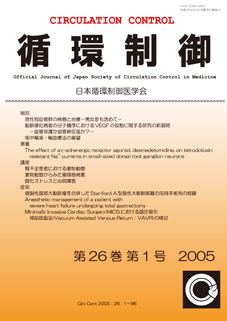All issues

Volume 26 (2005)
- Issue 4 Pages 314-
- Issue 3 Pages 247-
- Issue 2 Pages 140-
- Issue 1 Pages 24-
Volume 26, Issue 1
Displaying 1-4 of 4 articles from this issue
- |<
- <
- 1
- >
- >|
original articles
-
Miyuki Maruyama, Hirotsugu Okamoto, Takaaki Nakano, Hiroshi Kimotsuki, ...2005 Volume 26 Issue 1 Pages 24-28
Published: 2005
Released on J-STAGE: July 07, 2006
JOURNAL FREE ACCESSWe examined the effects of α2-adrenergic agonist, dexmedetomidine(DEX), on tetrodotoxin-resistant (TTX-r) Na+ currents using small-sized dorsal root ganglion(DRG) cells of the rats. Whole cell patch-clamp configuration was used. After control Na+ current was recorded, DEX was added to the extracellular solution. Yohimbine and prazosin were used to differentiate the contribution of α2-adrenergic receptor from that of α1-adrenergic receptor. The peak TTX-r Na+ currents were significantly and dose dependently inhibited by DEX(p<0.05). Yohimbine attenuated the suppressive effects of DEX on TTX-r Na+ currents, while prazosin did not alter the effects of DEX. Thus, DEX inhibited TTX-r Na+ currents by way of α2-adrenergic receptors but not α1-adrenergic receptors. Therefore, it is suggested that DEX has an inhibitory effect on TTX-r Na+ channels through α2-adrenergic receptors.View full abstractDownload PDF (151K)
case reports
-
Nobuaki Kaki, Kihito Irie, Yasuhiro Satoh, Ikkoku Hata, Hirotugu Yoshi ...2005 Volume 26 Issue 1 Pages 50-53
Published: 2005
Released on J-STAGE: July 07, 2006
JOURNAL FREE ACCESSWe experienced a case of emergent concurrent operations for Stanford A-type acute aortic dissection and ruptured abdominal aortic aneurysm. Two days after the onset of Stanford A-type acute aortic dissection, a 75-year-old male patient was hospitalized in our institution due to circulatory shock caused by ruptured abdominal aortic aneurysm. At admission, necrosis was observed in the toes of both sides. Concurrent operations for the replacements of the ascending aorta and abdominal aorta were uneventfully performed under deep hypothermia and circulatory arrest. Since the necrosis of the right lower leg was exacerbated, the surgical amputation was performed on the first postoperative day. The amputation of the left lower leg was also considered, because of the considerable exacerbation of the necrosis, but his family refused it and he died on the second post-operative day.View full abstractDownload PDF (689K) -
Seijiro Sonoda, Kinya Nishimura, Eiichi Inada, Toyoki Kugimiya, Toyo M ...2005 Volume 26 Issue 1 Pages 54-57
Published: 2005
Released on J-STAGE: July 07, 2006
JOURNAL FREE ACCESSWe report successful anesthetic management of a patient with severe congestive heart failure(CHF). A 77-year-old male underwent total gastrectomy for the gastric cancer. He had been diagnosed of severe CHF like as dilated cardiomyopathy previously. The cardiac ultrasonography showed the enlarged left ventricle(LV) with LV diastolic internal dimension of 62mm and LV ejection fraction of 20%. Dopamine and colforsin daropate hydrochloride were administered to support cardiovascular performance. The cardiac index monitored by HemosonicTM was maintained over 3.0 liters/min/m2. The patient was weaned from the respirator 5 days after surgery and recovered to discharge by about 2 months.View full abstractDownload PDF (310K) -
Hirotsugu Yoshida, Yoshihito Irie, Nobuaki Kaki, Yasuhiro Sato, Ikkoku ...2005 Volume 26 Issue 1 Pages 58-61
Published: 2005
Released on J-STAGE: July 07, 2006
JOURNAL FREE ACCESSWe have adopted Minimally Invasive Cardiac Surgery(MICS) through partial sternotomy since July 1997. Eighty two patients underwent mitral valve replacement with the MICS technique. Some patients needed a vacuum assisted venous return method(VAVR) to institute the extracorporeal circulation, because of the small operation field and thinner drainage tubes. We compared perioperative data in patients with and without VAVR, which was employed according to the three Committee guideline in MICS in Japan. The mortality rate was 2.4% and the cause of death was thromboembolism. There were no significant differences between the VAVR group and the non-VAVR group in intraoperative and postoperative factors. There was high frequency of usage of VAVR system in patients over 1.5m2 body surface area.View full abstractDownload PDF (50K)
- |<
- <
- 1
- >
- >|